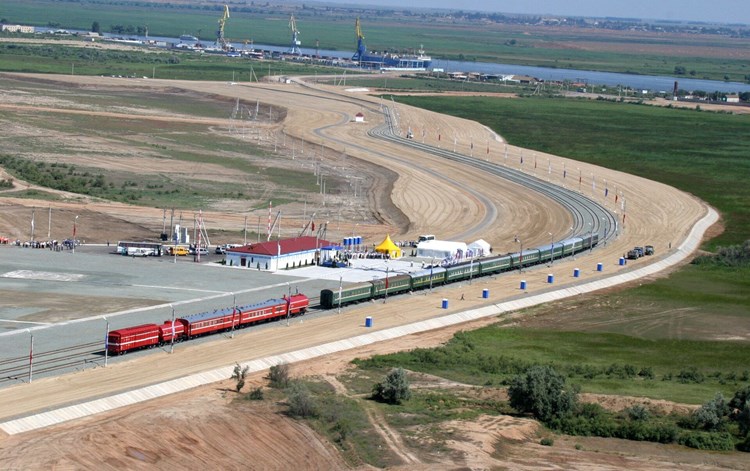https://www.almayadeen.net/news/economic/تفعيل-الممر-الجديد-للتجارة-بين-الهند-وروسيا-عبر-إيران
Source: Agencies + al-Mayadeen net 8 July 14:15
India motivates Iran to activate the international transport corridor between the North and the South stretching to 7200 kilometers.
The Tribune newspaper mentioned that India stimulates Iran in a series of high-level negotiations to activate the international transport corridor between the North and the South within the “INSTC” network stretching to 7200 kilometers.
The INSTC multi-method transport network stenches out via a sea route, land route, and a railroad network between Russia and India, which later achieved a bilateral trade volume of some $13 billion at the end of 2021. This trade multiplied on oil and other commodities with the Russian military operation in Ukraine.
أعلنت شركة الخدمات اللوجستية الروسية RZD Logistics أنها بدأت بنقل البضائع من #روسيا إلى الهند عبر الفرع الشرقي من ممر النقل الدولي بين الشمال والجنوب (INSTC)،الذي يربط البنية التحتية في روسيا وكازاخستان وتركمانستان وإيران والهند.تظهر الطرق التجريبية أن الممر أرخص ب30٪ وأقصر ب 40٪ pic.twitter.com/8tJxD2zP6s
— Mohamad Hasan Sweidan (@mhmdsweidan) July 7, 2022
The trade between India and Russia is on the brink of greatly being cheaper and faster, as it was decided that Iran shall be the main nexus for the new trade corridor.
Dozens of Central Asian states, like Armenia, Azerbaijan, and Georgia, along with the southern region of Russia will benefit from the trade via this network.
The works showed a decrease of time via this route by becoming 25 days compared to the previous time, which needed some 40 to 45 days. This means a 30% drop in transport costs.
This network is removing the complications, as it forms a pin alternative to the Suez Channel, as the Western states have no control over it.
The newspaper added that “it is interesting to know that all the 18 states affected by the INSTC route are not at all supporting the unilateral sanctions imposed by the West”, while the trade routes within the region were cut because of the Western sanctions against Russia and Iran.
On its behalf, the Economic Times newspaper mentioned that Russia launched full train containers to India via the eastern route of the INSTC, and in the long run the INSTC May become an alternative to the traditional routes, like the Suez Channel, the Mediterranean Sea, and the Bosporus.
India asked the Iranian port of the Čābahār to become part of the INSTC network, as it gives sea access to Afghanistan and it excels as a trade crossing hub for the region.
The relations of India with Iran count to be decisive to be relied on for the Iranian crude oil despite the American sanctions which left behind chaos even geographically, while Iran is special for offering an alternative route to Afghanistan and Central Asia circumventing Pakistan.
In 2000 Iran, Russia and India signed a preliminary document to set up an international transport corridor between the North and the South (INSTC), however, it was only in the middle of June this year when Tehran started to transport goods from the Russian port of Astrakhan via the Caspian Sea to the Iranian port of Bandar Anzalī, make the transport at the end arrive to the Indian port of Nahava Shifa.
Pic: International transport corridor between the North and the South consisting of railway and sea transport route networks.
تفعيل الممر الجديد للتجارة بين الهند وروسيا عبر إيران
المصدر: وكالات + الميادين نت 8 تموز 14:15
الهند تحث إيران على تفعيل ممر النقل الدولي بين الشمال والجنوب الممتد على طول 7200 كيلو متر
ذكرت صحيفة “تريبيون” أن الهند حثت إيران، في سلسلة محادثات رفيعة المستوى، على تفعيل ممر النقل الدولي بين الشمال والجنوب ضمن شبكة “INSTC” البالغ طوله 7200 كيلو متر.
وتعدّ “INSTC” شبكة نقل متعددة الوسائط، من الطرق البحرية والطرق البرية والسكك الحديدية، بين روسيا والهند، اللتين حققتا تجارة ثنائية تقدر بنحو 13 مليار دولار في نهاية العام 2021. وتضاعفت هذه التجارة على النفط والسلع الأخرى مع العملية العسكرية الروسية في أوكرانيا
وتوشك تجارة الهند مع روسيا على أن تصبح أرخص وأسرع إلى حدٍ كبير، إذ من المقرر أن تصبح إيران مركزاً رئيسياً لممر النقل الجديد.
وستستفيد العشرات من دول آسيا الوسطى مثل أرمينيا وأذربيجان وجورجيا، إلى جانب منطقة جنوب روسيا، من التجارة من خلال هذه الشبكة.
وأظهرت عمليات التشغيل انخفاض وقت العبور على هذا الطريق بما يصل إلى 25 يوماً، مقارنة بالأوقات السابقة التي كانت تستغرق من 40 إلى 45 يوماً، ما أدى إلى خفض تكاليف النقل بنسبة 30%.
وهذه الشبكة معفاة من العقوبات؛ لأنها تشكل بديلاً لقناة السويس لا تهيمن عليه الدول الغربية.
وأضافت الصحيفة أنه “من المثير للاهتمام، أن جميع الدول الـ 18 التي تأثرت بمسار INSTC لم تكن أبداً داعمة نشطة للعقوبات الأحادية الجانب التي أعلنها الغرب”، بينما تعطلت الروابط التجارية داخل المنطقة بسبب العقوبات الغربية على روسيا وإيران.
بدورها، ذكرت صحيفة “إيكونوميك تايمز” أن روسيا بدأت في نقل قطارات كاملة الحاويات إلى الهند عبر الفرع الشرقي لـ INSTC. وأنه على المدى الطويل، يمكن أن تكون INSTC بديلاً للطرق التقليدية مثل قناة السويس والبحر الأبيض المتوسط ومضيق البوسفور.
وطلبت الهند من ميناء، تشابهار الإيراني، أن يكون جزءاً من شبكة INSTC، إذ يوفر منفذاً بحرياً إلى أفغانستان، ويبرز كمركز عبور تجاري للمنطقة.
وتعدّ علاقات الهند بإيران حاسمة بالنظر إلى اعتمادها على النفط الخام الإيراني، على الرغم من العقوبات الأميركية التي تركت الأمور في حالة من الفوضى. حتى من الناحية الجغرافية، تتميّز إيران بأنها توفر طريقاً بديلاً لأفغانستان وآسيا الوسطى، متجنبة باكستان.
وفي عام 2000، وقعت كل من روسيا وإيران والهند على الوثيقة الأولى لإنشاء الممر الدولي للنقل بين الشمال والجنوب (INSTC)، إلا أنه في منتصف شهر حزيران/ يونيو الماضي، بدأت طهران بنقل البضائع من ميناء أستراخان الروسي مروراً ببحر قزوين، فميناء أنزلي الإيراني، على أن يتم شحن الحمولة بحراً إلى ميناء “نهافا شيفا” الهندي


